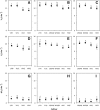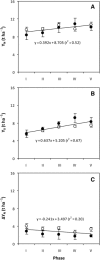Higher yields of hybrid rice do not depend on nitrogen fertilization under moderate to high soil fertility conditions
- PMID: 28936774
- PMCID: PMC5608657
- DOI: 10.1186/s12284-017-0182-1
Higher yields of hybrid rice do not depend on nitrogen fertilization under moderate to high soil fertility conditions
Abstract
Background: Increasing rice yield with fewer external inputs is critical to ensuring food security, reducing environmental costs, and improving returns. Use of hybrid rice has expanded greatly in China due to its higher yield potential. Meanwhile, large and increasing amounts of nitrogen (N) fertilizers have been used for expanding rice production in China. It is not clear to what extent the success of hybrid rice in China is associated with N fertilizer inputs.
Findings: We observed that the higher grain yield with N fertilizer in hybrid rice was driven more by a higher yield without N fertilizer than by increases in grain yield with N fertilizer under moderate to high soil fertility conditions.
Conclusions: Our results suggest that greater application of N fertilizers is not needed to benefit from hybrid rice production under moderate to high soil fertility conditions, and that improving and maintaining soil fertility should be a focus for sustaining hybrid rice production. Moreover, our study also indicates that zero-N testing may be a potentially useful tool to develop hybrid rice with high yield and without requirement of greater external N inputs under moderate to high soil fertility conditions.
Keywords: Grain yield; Hybrid rice; Nitrogen inputs; Sustainable crop production.
Conflict of interest statement
Competing interests
The authors declare that they have no competing interests.
Publisher’s Note
Springer Nature remains neutral with regard to jurisdictional claims in published maps and institutional affiliations.
Figures



References
-
- Chen X, Cui Z, Fan M, Vitousek P, Zhao M, Ma W, Wang Z, Zhang W, Yan X, Yang J, Deng X, Gao Q, Zhang Q, Gui S, Ren J, Li S, Ye Y, Wang Z, Huang J, Tang Q, Sun Y, Peng X, Zhang J, He M, Zhu Y, Xue J, Wang G, Wu L, An N, Wu L, Ma L, Zhang W, Zhang F. Producing more grain with lower environmental costs. Nature. 2014;514:486–489. doi: 10.1038/nature13609. - DOI - PubMed
-
- Cheng SH, Cao LY, Yang SH, Zhai HQ. Forty years’ development of hybrid rice: China’s experience. Rice Sci. 2004;11:225–230.
-
- Davidson EA. The contribution of manure and fertilizer nitrogen to atmospheric nitrous oxide since 1860. Nat Geosci. 2009;2:659–662. doi: 10.1038/ngeo608. - DOI
LinkOut - more resources
Full Text Sources
Other Literature Sources

